Plant Profiles
Click on the first letter of the common name of the plant you wish more information about.
A | B | C | D | E | F | G | H | I | J | K | L | M | N | O | P | Q | R | S | T | U | V | W | X | Y | Z
F
- False Heather
- Fan Flower
- Fire Thorn
- Firespike
- Flame Vine
- Flax Lily, Variegated
- Florida Anise
- Foxglove
- Frangipani

False Heather
Scientific Name: Cuphea hyssopifolia
Growth Habit: A shrublike perennial with small dark evergreen leaves on rounded multistemmed plants growing to 18 inches tall and wide.
Light: Plant in full-sun to lightly shaded locations.
Feedings: Apply a general garden fertilizer once every 6 to 8 weeks March through November.
Water Needs: Tolerates short periods of drought; grows best with weekly waterings.
Ease of Culture: Easy.
Propagation: Start new plants from cuttings.
Hardiness: Tender; damaged by severe frosts and freezes but usually survives from buds below mulches near the ground.
Major Problems: Small blue metallic beetles are heavy feeders especially during the spring. Control as needed with a pesticide labeled for chewing insects.
Pruning: Plants produce vigorous growth and may need trimming to keep in bounds along walkways. If damaged by cold, plants may be trimmed back to near the ground to encourage new shoots.
Uses: False heather, also known as Mexican heather, is an old garden favorite with year-round lavender to pink blooms. Interest in the plant was revived with the introduction of newer varieties including Alba with white blooms and Allyson bearing slightly larger leaves and more blossoms. It's often planted as a ground cover, a perennial garden addition or edging along walkways. Small plants can be worked into dish gardens and hanging baskets.
Florida Native: No; native to Mexico.
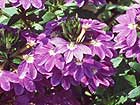
Fan Flower
Scientific Name: Scaevola aemula
Growth Habit: A sprawling perennial growing to 8 inches tall and more than 36 inches wide. The leaves are dark green, oblong and 1-inch long and a 1/2-inch wide.
Light: Plant in full-sun to lightly shaded locations.
Feedings: Apply a general garden fertilizer monthly to in-ground plantings and a 20-20-20 or similar fertilizer solutions to container plantings every other week. Slow-release fertilizers also can be used.
Water Needs: Tolerates short periods of drought; water in-ground plantings weekly and container plantings when the surface soil begins to dry.
Ease of Culture: Easy.
Propagation: Start plants by cuttings.
Hardiness: Tender; protect plants from frosts and freezing weather.
Major Problems: Plant in a well-drained soil to avoid root-rot problems. Also control whitefly and garden flea hopper insects to prevent foliage decline.
Pruning: Encourage branching and full plants by pruning the tips of shoots as needed. Also trim to keep in bounds and to renew the vigor of older plants.
Uses: An attractive perennial frequently grown as an annual in home and commercial landscapes. Plant as a ground cover or edging for flower beds and shrub plantings. Also add to hanging baskets and mixed planters where stems can cascade over the sides. Plantings bloom year-round, opening clusters of purplish fan-shaped blossoms.
Florida Native: No; native to Australia.
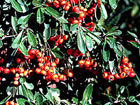
Fire Thorn
Scientific Name: Pyracantha coccinea
Growth Habit: A sprawling, thorny, evergreen shrub with numerous twigs on shoots growing to 10 feet tall. The leaves are narrow, shiny and bright green, growing to more than an inch long and half as wide.
Light: Plant in full sun to light, shifting shade.
Feedings: Apply a general garden fertilizer once each month in March, June and September.
Water Needs: Tolerates short periods of drought; grows best with waterings every other week.
Ease of Culture: Easy.
Propagation: Start plants from cuttings.
Hardiness: Hardy.
Major Problems: New shoots often are attacked by aphids and leaves by whiteflies. Leaves also may turn brown during the drier months because of mite populations. All these pests can be controlled with soap or oil sprays available from garden centers.
Pruning: Many gardeners like to train the fire thorn, also commonly called pyracantha, to a trellis or use the plants to create a topiary. This involves directing shoots where needed to fill out the display and trimming the ends to cause branching. Plants growing as free-standing shrubs also need periodic trimming to remain in bounds and encourage new fruiting shoots.
Uses: A good accent shrub and thorny barrier for the landscape. Topiaries and plants trained to a trellis often are used near patios, entrances and along walkways. Plantings also can be used as a hedge or a backdrop for gardens. The shrubs fill with white blossoms in March or April that are followed by quarter-inch berries that mature an orange to red color for displays October through February. The fruits are a favorite food for wildlife.
Florida Native: No; native to Europe and Asia.
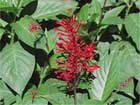
Firespike
Scientific Name: Odontonema strictum
Growth Habit: Upright clump-forming evergreen perennials growing to 8 feet tall. The leaves are shiny and bright green, growing to 8 inches long and 4 inches wide.
Light: Plant in full-sun to lightly shaded locations.
Feedings: Apply a general garden fertilizer every six to eight weeks March through November.
Water Needs: Prefers a moist soil; grows best with weekly waterings.
Ease of Culture: Easy.
Propagation: Start plantings from seed, cuttings and division of older clumps.
Hardiness: Tender; damaged by frosts and freezes, but grows back from buds near the ground.
Major Problems: Chewing insects including grasshoppers and caterpillars occasionally may damage the foliage, but seldom need control.
Pruning: Trim in late February to remove declining plant portions injured by cold. Also use this time to reduce height and width to keep plants in bounds. Additional pruning may be needed during the growing season to remove shoots hanging over walkways and affecting nearby plantings.
Uses: Plant a cluster of firespike plants 3 to 4 feet apart as a backdrop or border for gardens, patios and walkways. Even when damaged by cold, the plants regrow quickly to form a view barrier and attractive accent with unusual, often footlong, flattened spikes of bright red flowers. This is an excellent plant for the butterfly garden.
Florida Native: No; native to Central America.
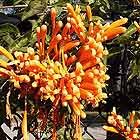
Flame Vine
Scientific Name: Pyrostegia venusta
Growth Habit: An evergreen, often rampant, vine with shoots growing to 30 feet long. The leaves are medium green with two to three elliptic leaflets each growing to 3 inches long and half as wide.
Light: Plant in a full-sun location.
Feedings: Fertilize in March and June with a general garden fertilizer if needed to encourage growth.
Water Needs: Drought tolerant; water frequently when young to help develop the root system. Established vines normally survive with seasonal rains.
Ease of Culture: Easy.
Propagation: Start plants from cuttings and air layers.
Hardiness: Medium; damaged by severe freezes but grows back from buds near the ground.
Major Problems: Plants may be damaged by caterpillars that chew holes in the leaves, but controls seldom are needed. The vines also may be affected by scale insects and mites, which can be controlled with natural oil sprays when noted.
Pruning: Keep plantings to the desired area with a yearly pruning immediately after flowering. Additional trimming may be needed during the growing season to restrict growth further. Remove all dead or declining portions after severe freezes.
Uses: A colorful February-through-March flowering vine opening clusters of bright orange tubular flowers. Vines can be used to create view barriers and overhead covers or to form an accent when trained to a trellis, an arbor or a fence. Plant only where the shoots have lots of room to grow. Do not use near trees or shrubs where the vining stems often climb out of control to compete with these plantings.
Florida Native: No; native to Brazil and Paraguay.
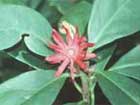
Florida Anise
Scientific Name: Illicium floridanum
Growth Habit: An evergreen rounded shrub with an open branching habit growing to 10 feet tall and 8 feet wide. The leaves are deep green and lancelike, growing to 6 inches long and half as wide.
Light: Grows in full sun to shady locations.
Feedings: Apply a general garden fertilizer once monthly in March, June and September.
Water Needs: Prefers damp locations; water at least weekly.
Ease of Culture: Easy.
Propagation: From seeds or cuttings.
Hardiness: Hardy.
Major Problems: Leaves and stems may be affected by scale insects, which encourage sooty mold. Control as needed with a natural oil spray.
Pruning: Where possible the anise should be grown as a naturally shaped shrub, but it can be pruned to a more formal look. If needed, prune individual stems to keep them in bounds or encourage a compact growth habit. Avoid shearing, which leaves brown edges among the foliage.
Uses: Plant as a backdrop for gardens, a foundation plant or a view barrier along property lines. It's one of the few shrubs that grow well in the shady and damp areas of the landscape. Plantings produce 2-inch-diameter reddish blooms March through April, followed by an ornamental-looking, star-shaped seedpod. The leaves give off a licorice fragrance when crushed.
Florida Native: Yes.
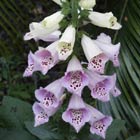
Foxglove
Scientific Name: Digitalis purpurea
Growth Habit: An evergreen biennial forming 12-inch-tall rosettes of foliage near the ground during the fall and winter months. During spring, the plants develop flowering shoots to 36 inches tall. The leaves are deep green and often hairy and grow to 10 inches long and half as wide.
Light: Grow in a full-sun location.
Feedings: Apply a general garden fertilizer monthly until flowering time.
Water Needs: Plants need a moist soil; water at least once a week during the drier winter through spring.
Ease of Culture: Medium; gardeners may have to start their own plants from seed.
Propagation: Start plants from seed. One variety that performs well locally is the Foxy hybrid.
Hardiness: Hardy; damaged by severe freezes.
Major Problems: Chewing insects may produce holes in the leaves but seldom need control. Plants need a period of cold during the winter to flower in Florida gardens.
Pruning: Foxgloves often grow larger than expected, and some leaves may have to be removed to prevent crowding of nearby plants. Remove the plants after flowering, and replant with other flowers.
Uses: An attractive addition to the cool-season flower garden, producing spikes of tubelike white, pink or purple blossoms. Gardeners can start their own seeds each fall or purchase plants in bloom during spring at local garden centers. Plant in clusters with other annual or perennial flowers to produce the best displays. Plants also can be added to container gardens. All portions of the foxglove are poisonous if eaten.
Florida Native: No; native to Portugal and Spain.
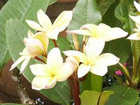
Frangipani
Scientific Name: Plumeria species
Growth Habit: A deciduous small tree with an open growth habit producing large-diameter, gray-green stems. The tree grows to 12 feet tall in subtropical Central Florida, 22 feet in more tropical climates. The leaves are medium green and elliptic in shape and grow to 20 inches long and 6 inches wide.
Light: Grow in full-sun locations.
Feedings: Feed in-ground plantings every other month March through October with a general garden fertilizer. Feed container plantings with a 20-20-20 or similar product monthly or use a slow-release fertilizer as instructed on the label.
Water Needs: Drought tolerant; survives without water but drops leaves during severe drought. Grows best in well-drained but moist soils during the warmer months. Little water is needed during the winter months.
Ease of Culture: Medium; cold sensitive.
Propagation: Start plants from stem cuttings. Allow the cut stems to dry a day or two before beginning the rooting process.
Hardiness: Tender; needs cold protection during the winter months.
Major Problems: A rust disease is most noticeable during the summer months, producing orange pustules on the leaves. Control with a fungicide labeled for rust. Scale insects also are noted often and can be controlled with a natural oil spray.
Pruning: Reshape plants at the beginning of the spring growing season and remove winter damage. Errant shoots may be removed during the warmer months as needed.
Uses: An attractive small accent tree well-known for fragrant white, red, yellow or pink blossoms opening May through November. The blossoms are used in Hawaiian leis. May be planted in the ground in protected warm locations, but in Central Florida, they more commonly are grown in large containers. May be used for patio and balcony displays or set throughout the landscape to create a tropical look.
Florida Native: No; native to the Caribbean region and Central America.